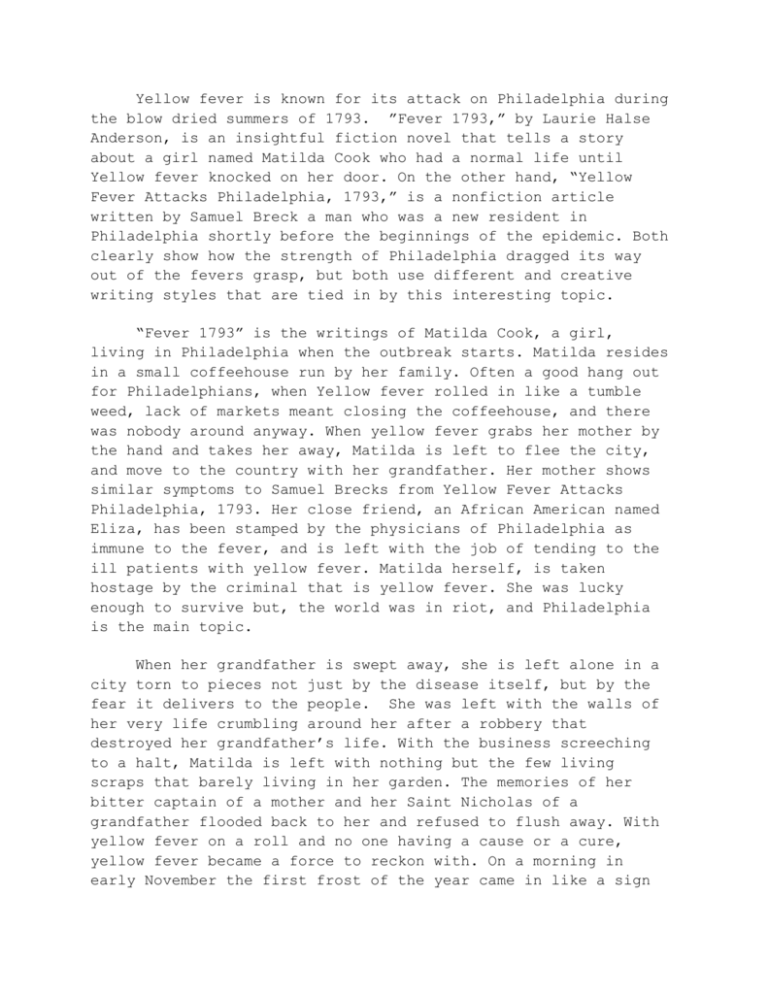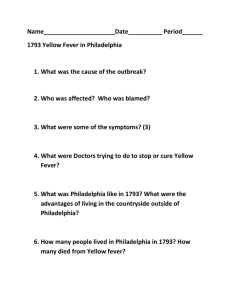CC Done - Anoka-Hennepin School District
advertisement

Yellow fever is known for its attack on Philadelphia during the blow dried summers of 1793. ”Fever 1793,” by Laurie Halse Anderson, is an insightful fiction novel that tells a story about a girl named Matilda Cook who had a normal life until Yellow fever knocked on her door. On the other hand, “Yellow Fever Attacks Philadelphia, 1793,” is a nonfiction article written by Samuel Breck a man who was a new resident in Philadelphia shortly before the beginnings of the epidemic. Both clearly show how the strength of Philadelphia dragged its way out of the fevers grasp, but both use different and creative writing styles that are tied in by this interesting topic. “Fever 1793” is the writings of Matilda Cook, a girl, living in Philadelphia when the outbreak starts. Matilda resides in a small coffeehouse run by her family. Often a good hang out for Philadelphians, when Yellow fever rolled in like a tumble weed, lack of markets meant closing the coffeehouse, and there was nobody around anyway. When yellow fever grabs her mother by the hand and takes her away, Matilda is left to flee the city, and move to the country with her grandfather. Her mother shows similar symptoms to Samuel Brecks from Yellow Fever Attacks Philadelphia, 1793. Her close friend, an African American named Eliza, has been stamped by the physicians of Philadelphia as immune to the fever, and is left with the job of tending to the ill patients with yellow fever. Matilda herself, is taken hostage by the criminal that is yellow fever. She was lucky enough to survive but, the world was in riot, and Philadelphia is the main topic. When her grandfather is swept away, she is left alone in a city torn to pieces not just by the disease itself, but by the fear it delivers to the people. She was left with the walls of her very life crumbling around her after a robbery that destroyed her grandfather’s life. With the business screeching to a halt, Matilda is left with nothing but the few living scraps that barely living in her garden. The memories of her bitter captain of a mother and her Saint Nicholas of a grandfather flooded back to her and refused to flush away. With yellow fever on a roll and no one having a cause or a cure, yellow fever became a force to reckon with. On a morning in early November the first frost of the year came in like a sign from the heavens. With the curse of yellow fever broken, Matilda returns to her mother and gets comfortable for the ride on the road to recovery. Although “Fever 1793”captures the plague to some extent, nobody can recreate the blood curdling fear that came in the yellow fever package better than someone who lived through it. “Yellow Fever Attacks Philadelphia, 1793” gives a great view of the unexpected epidemic, unlike “Fever 1793” it is written with surreal accuracy. Beginning with an exceedingly large number of residents in Philadelphia (about 55,000) at the time of the outbreak, you could see how the plague could cause a dangerous amount of danger and destruction. Without the cities knowledge, their fair city was turning into a mosquitoes’ playground. Adding to the chaos the Physicians of Philadelphia were struggling to fit what seemed like a million puzzle pieces together and the cities medical community found themselves befuddled. Samuel Breck was met with the misfortune of settling in Philadelphia shortly before he was given the distasteful housewarming gift of his city in peril. Samuel was forced to play a game a follow suit when his father fled to Bristol on the Delaware. With the attack of this disease becoming a devastating war, yellow fever was in its prime, and Philadelphia was hanging on by a thread. Yellow fever had become a silent killer, but the battle was about to end and Philadelphia would stand on top. The destruction this memorable affliction boldly left its mark on history. Philadelphia was abandoned. Samuel Breck had opened his front door and answered to the fever. Breck luckily escaped yellow fevers grasp and found that the disease was at its peak, and the death toll was going up in hundreds. Breck recalls the experience of his father’s neighbor “The attendants on the dead stood in the pavement soliciting jobs”. On the cold frosty morning November 9th 1793, a chilling northwest breeze sailed through Philadelphia marking the first frost of the year and the end of yellow fever. To this day yellow fever still sends chills up the cities spines as many people recall the misfortune that was brought upon the now thriving city. “Fever 1793” by Laurie Halse Anderson is an insightful and creative novel, featuring the heroine of the story Matilda Cook who is caught in the middle of the epidemic. Likewise “Yellow Fever Attacks Philadelphia, 1793” by Samuel Breck is a nonfiction article with a unique view of the fever from someone who was still a stranger to most in the city. Thus they both showed how destructive yellow fever was while also bringing in the interesting points of view only fiction or nonfiction could have brought to the table.








